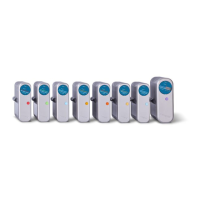ENGINEERING MANUAL OF AUTOMATIC CONTROL
CONTROL FUNDAMENTALS
30
Each control mode is applicable to processes having certain
combinations of the basic characteristics. The simplest mode
of control that meets application requirements is the best mode
to use, both for economy and for best results. Using a control
mode that is too complicated for the application may result in
Table 3. Control Applications and Recommended Control Modes.
CONTROL SYSTEM COMPONENTS
M10518
poor rather than good control. Conversely, using a control mode
that is too basic for requirements can make adequate control
impossible. Table 3 lists typical control applications and
recommended control modes.
Control system components consist of sensing elements,
controllers, actuators, and auxiliary equipment.
SENSING ELEMENTS
A sensing element measures the value of the controlled
variable. Controlled variables most often sensed in HVAC
systems are temperature, pressure, relative humidity, and flow.
TEMPERATURE SENSING ELEMENTS
The sensing element in a temperature sensor can be a bimetal
strip, a rod-and-tube element, a sealed bellows, a sealed bellows
attached to a capillary or bulb, a resistive wire, or a thermistor.
Refer to the Electronic Control Fundamentals section of this
manual for Electronic Sensors for Microprocessor Based Systems.
A bimetal element is a thin metallic strip composed of two
layers of different kinds of metal. Because the two metals have
different rates of heat expansion, the curvature of the bimetal
changes with changes in temperature. The resulting movement
of the bimetal can be used to open or close circuits in electric
control systems or regulate airflow through nozzles in
pneumatic control systems. Winding the bimetal in a coil
(Fig. 49) enables a greater length of the bimetal to be used in
a limited space.
Fig. 49. Coiled Bimetal Element.
The rod-and-tube element (Fig. 50) also uses the principle
of expansion of metals. It is used primarily for insertion directly
into a controlled medium, such as water or air. In a typical
pneumatic device, a brass tube contains an Invar rod which is
fastened at one end to the tube and at the other end to a spring
and flapper. Brass has the higher expansion coefficient and is
placed outside to be in direct contact with the measured medium.
Invar does not expand noticeably with temperature changes.
As the brass tube expands lengthwise, it pulls the Invar rod
with it and changes the force on the flapper. The flapper is used
to generate a pneumatic signal. When the flapper position
changes, the signal changes correspondingly.
Control Application Recommended Control Mode
a
Space Temperature P, PID
Mixed Air Temperature PI, EPID
Coil Discharge Temperature PI, EPID
Chiller Discharge Temperature PI, EPID
Hot Water Converter Discharge Temperature PI, EPID
Airflow PI Use a wide proportional band and a fast reset rate. For some
applications, PID may be required.
Fan Static Pressure PI, EPID
Humidity P, or if very tight control is required, PI
Dewpoint Temperature P, or if very tight control is required, PI
a
PID, EPID control is used in digital systems.

